Hunting for jets in the High Sierra with Camden Thrasher
There is no sound, at first. They bank in silently under the ridgeline and below your feet, precise and deliberate little motions, slower than you expect—matte-gray shapes, dirty-looking, too distant to make out and then seemingly close enough to touch. The noise comes an instant later, various gases being burned and shoved aside, deafening and metallic.
At 9:00 that morning, before the sun had driven the chill from the air, we parked the Jeep and the Land Rover at the base of a trail in the high Sierra and began to hike. Forty minutes later, we were 4300 feet above sea level and maybe 1000 feet above the trucks, standing on a rocky outcropping that hung over the valley like an opera balcony.
Camden Thrasher set his backpack down and began fiddling with a hand-held radio scanner. He glanced up at the sky for a moment.
“Last time I was here, it was 105 degrees. This is nice.”
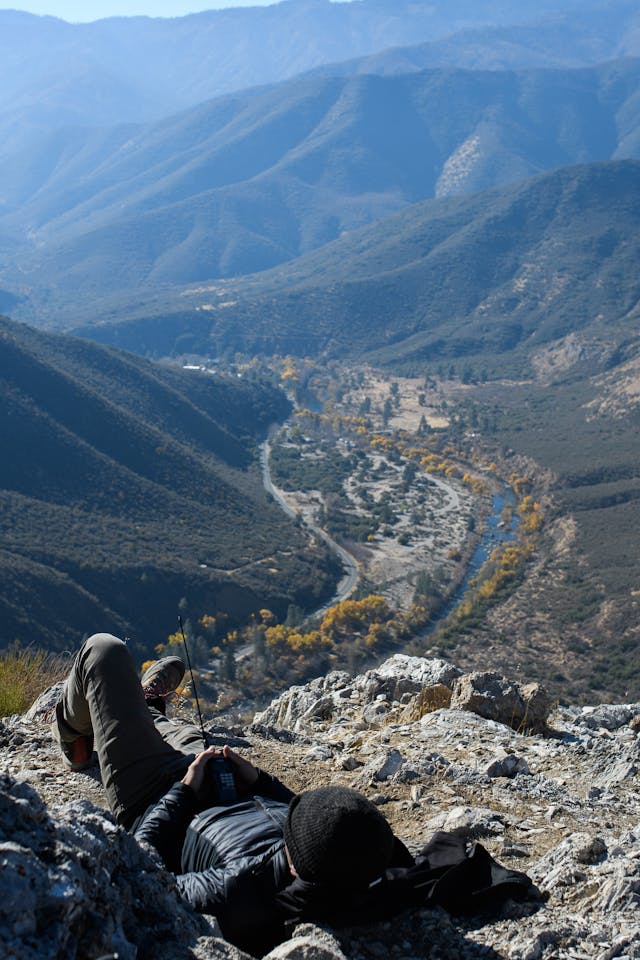
Camden is a professional motorsport photographer and friend. He lives in Georgia but grew up in Washington State, where airplane culture is as old as Boeing and Navy jets carve low over alpine lakes. In his day job, Camden has shot the Baja 1000 and the 12 Hours of Sebring and pretty much everything in between. He has a delightful habit of saying profound things in an unprofound manner and is easily bored. A few years ago, during a particularly quiet off-season, he picked up a welder and turned his BMW 2002 into an off-road mutt with tall knobbies and a six-cylinder swap.
Around the same time, apropos of nothing, he decided to start spending his vacations hiking into the backcountry to photograph military aircraft flying balls-out at low altitude.
Once, a while back, I asked him why he did this.
Afterburner jets, a few hundred feet off the ground, close enough to spit at, he said.
I suddenly felt big stupid for asking.
Come along, he said.
Twist my arm, I answered.

And so one day last fall, we drove into nowhere California and watched Air Force and Navy pilots do low-level training runs—500 mph and a few hundred feet off the deck, in all manner of fast airplanes. Because nowhere is usually off the beaten path, we borrowed a Jeep Wrangler and a Land Rover Defender. The connection seemed obvious: Purposeful hardware and speed are powerful drugs, regardless of form; car people are often airplane people, and vice versa. For me, the blame for this form of infatuation can be traced to my father, a former professional pilot who once told me that he got into flying “for the airplanes.” One of those subjects that just remains permanently novel and intoxicating, no matter how old you get.
The wind rustled in the trees. I threw a furtive glance east, toward the mouth of the valley. Camden, head down and adjusting something on his camera, waved, dismissive.
“When you’re looking for jets, everything out here sounds like a jet.”
“Oh.” My shoulders fell. “Do you get any warning?”
He shrugged. “In theory, they’re supposed to make a radio call saying they’re entering this route. Whether they actually do or not is a mystery, and whether we can hear it on the scanner is another thing entirely.”

Twenty minutes passed. I grew tired of standing and sat down on a large rock. The hunt, Camden had told me, was half the fun, and it began with hours upon hours of research, at home—digging up military training routes online and locating them in the real world, but never knowing when or where the airplanes would actually show, because the American government doesn’t make a habit of publishing military flights, because of course it doesn’t.
“Lemoore, Fresno, China Lake, Nellis, Edwards,” Camden had said, as we hiked, that first day. “Five air bases within 100 miles of here—who knows what they’re doing. We could sit on a mountain and see nothing from sunrise to dark, or we could wait an hour and have 40 planes come through. It just depends.”
“What do you end up doing if you don’t see anything?”
“I dunno? Sit. Think.”
To the south, a small gray wedge popped out from behind a mountain. It snapped into a bank, then disappeared into a carpet of haze. An instant later, the wedge was below my feet, slicing through a gap in the landscape. The right wing passed my toes almost vertical.

“F-18,” Camden said.
The noise came an instant later. That feeling where your inner ear seems to boil.
I stood up, blinking. At the bottom of the mountain, our trucks sat there, as they had moments before. Only this time, they looked very small and very, very slow.
THE FIRST CLIMB
The scanner crackled: “400-plus knots, 500 feet.”
My skin tingled. An F-18 passed below, same as the last one, its gray underside canted up like a cat asking for a scratch.
Over the next six hours, that feeling recurred 20 times. Twenty-one, if you count the prop-driven Beechcraft King Air that ran the canyon almost too high to see. A King Air is not nothing, but it is also not a jet. Not the reason these routes exist.
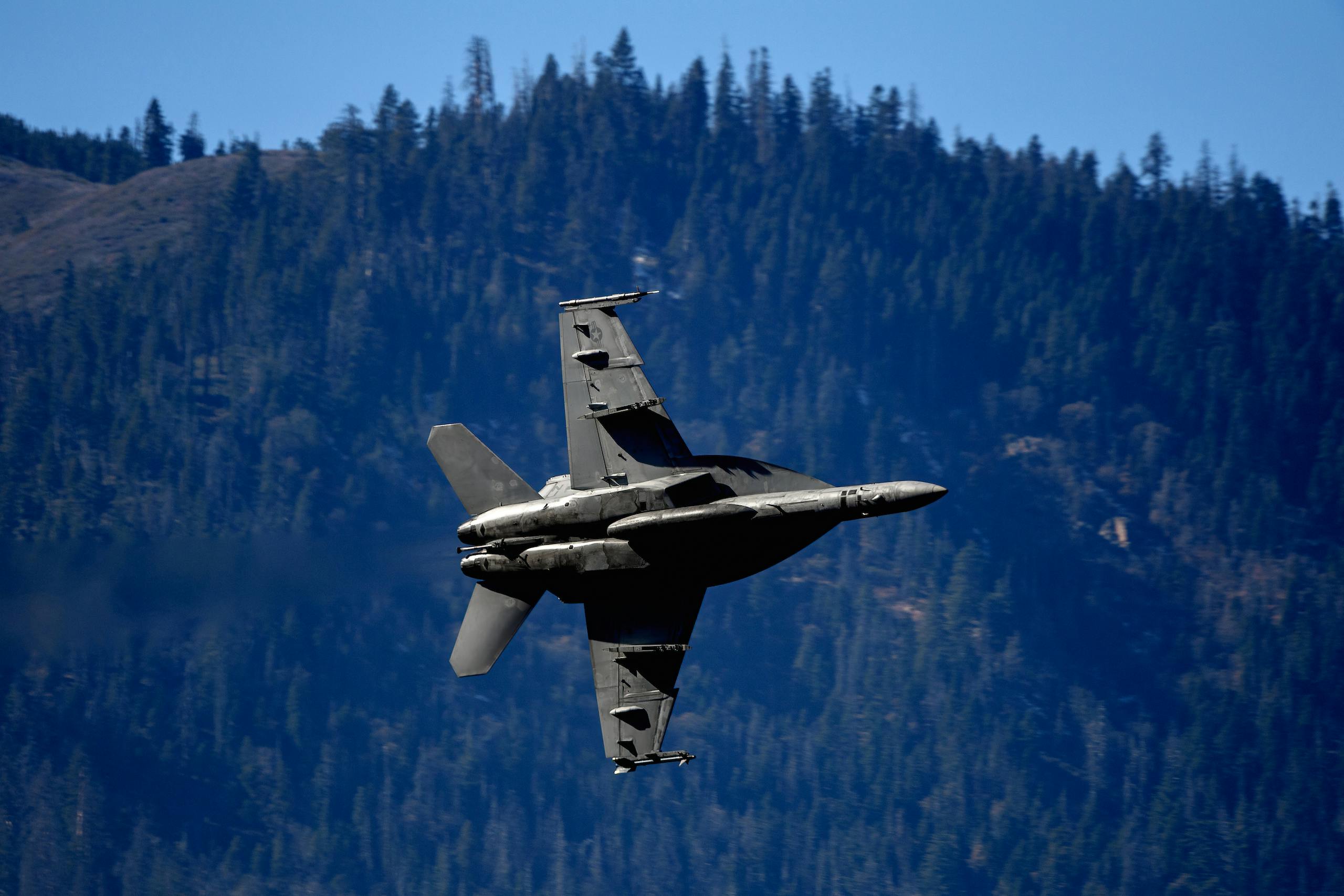
According to the Air Force website, the American military uses “some airspace below 10,000 feet for training operations.” In combat, it says, “many aircraft will operate at altitudes as low as 100 feet and at high airspeeds to defeat ground-missile radars and avoid sophisticated [defenses].”
In order to fly $67 million worth of jet at 100 feet and 600 mph, you need skill, and in a modern military environment, skill means training, which means hours in the cockpit and the kind of intensely manicured pilot proficiency in which the United States government has long specialized. The American military certifies pilots for low-level flight by degree, with an aviator’s low-altitude permission based on individual rating, and that rating based on altitude and aircraft—if you fly an F-35, for example, there is one rating for 500 feet, another for 300, and another for 100.
These ratings are qualified for and maintained through frequent bursts of simulator and flight time, and the attendant safety and proficiency protocols are serious as cancer. Many military pilots are rated for 500 feet. Very few are allowed to see 100. Nor do most civilians see these jets this low, period. In the continental U.S., low-level flights take place only in limited, charted airspace, generally where humans aren’t.
The FAA and Department of Defense maintain hundreds of Military Training Routes, or MTRs, for this exact purpose. The most famous of these routes live inside the R-2508 complex, over the southern Sierra Nevada and upper Mojave Desert, but similar training occurs in places like Idaho, the Cascades, and the West Virginia mountains. A YouTube search will show you what those routes look like from the cockpit, but the easiest shorthand is to simply picture the Death Star X-Wing runs in Star Wars, then replace the X-Wings with something from McDonnell-Douglas.
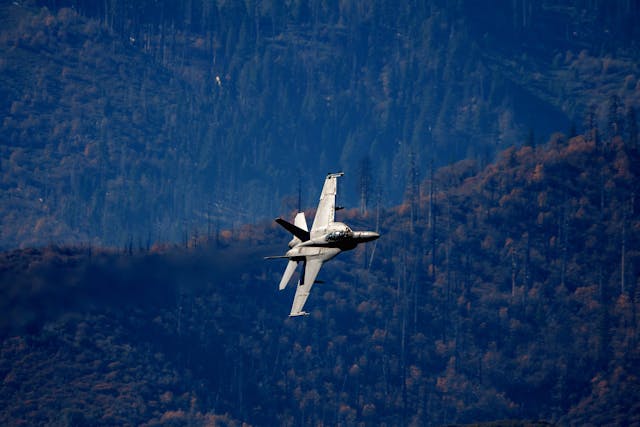
During background research for this story, I interviewed a handful of military flyers with low-level flight experience in afterburner aircraft.
“It is fun,” an F-18 aviator told me. “Oh hell yes, is it fun.”
“Fantastic to fly,” said another, an F-35 test pilot. “But… intense. You can’t afford to screw up, at all. At 100 feet, any error is going to be fatal.”
This kind of skill can be intoxicating to witness—so much precision shotgunned through such a small space—but the practice is not widely beloved. Conservationists protest the wildlife impact. Rural towns complain about noise. And above all, any time you have an airplane flying near the ground, especially an extremely fast airplane, there is risk. The single most popular jet-chasing location on earth, an overlook in Death Valley National Park, was officially closed to low-level flight in 2019 following an F-18 crash that killed the jet’s pilot and injured seven tourists. If you ever visit that particular overlook, the crash will seem remarkable, but not as remarkable as the fact that events of this nature are exceedingly rare.
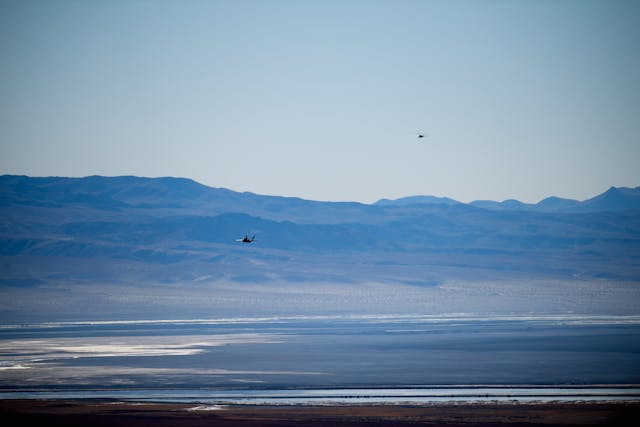
The similarities to car racing are not small, but apart from the obvious differences, there is one crucial separation that can make this pastime compelling for a spectator with an automotive bent. I have for the last two decades covered motorsport as a journalist, studying how skilled individuals think and react in extraordinary situations. I have also watched as more than a few international sanctioning bodies squeezed the life and spectacle from an otherwise breathtaking and spectacular practice.
Spend enough time watching one of your lifelong loves grow weak under the boot of bureaucracy, you get ideas. One of those notions centers around how getting your nose booped by a 600-mph airplane makes for a far better weekend than, say, trudging off to watch an F1 race where a bunch of oligarch scions compete to find out whose aerodynamicist is smarter and swimming in a larger pile of money.
I JUST WANT THE AIRPLANES
“I’m not an expert by any means,” Camden said. This in spite of having chased jets for several years, living out of a rental Jeep in the mountains for weeks at a time. He makes a habit of driving into the backcountry on short notice, bringing little more than a scanner, a camera, and several days’ worth of food. He went to Reno once, to shoot next to one of the air-race pylons. (“It’s kind of hard to get good stuff there, but it was neat to see what 500 mph looks like from about 50 feet away.”) He once kicked off a ten-hour drive on a day’s notice because a sympathetic pilot found him online and allowed as how his jet might soon be passing through a certain geographic region, perhaps, unofficially, ahem, cough, at high speed, yes.
You meet people like this, you ask why. Even if you know the answer.

“I don’t really have a good reason,” Camden said. “I just got into it after watching a bunch of videos online. I like the adventure aspect, hiking and road trips. You have to go find this stuff, it doesn’t find you. It takes a lot of work to figure out where the routes are, where they’re flying, and how to get to these places people don’t normally go. Which is kind of the point. And military airplanes are just impressive to watch.”
The government flies jets low all over the country, but the west coast is uniquely equipped for this sort of hunt. Credit a unique mix of spectacular terrain, millions of acres of public land, and a dense concentration of air bases. America long ago discovered that empty land and abundant sun made for good defense airfield, and so a lot of them got built, in greater density than much of the rest of the country.
Around lunchtime, the mountains grew quiet, air traffic gone. We talked for a bit about airplanes, how they can be like any other obsession. What it feels like to sit at a desk, engrossed in working and trying not to think about more exciting things. How my father was once a flight instructor but quit when I was young, after he realized that he couldn’t support a family without a much different job.
I mentioned Chuck Yeager’s autobiography and The Right Stuff, how the greatest test pilot in American history nearly died over the Mojave in an F-104 not far from the mountain where we sat. This somehow segued into a discussion of the much-delayed sequel to the Tom Cruise movie Top Gun.
Camden laughed. “Top Gun. I wish they would just release all the aerial footage. You know, like a ski film. I don’t want the plot. I just want the airplanes.”
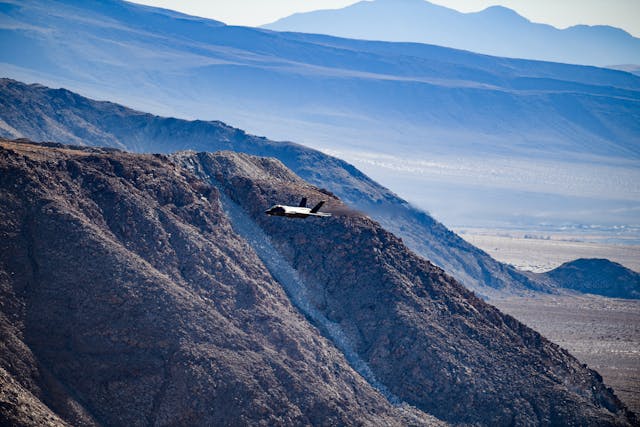
Ski films are basically just hours of lavishly shot downhill footage set to music, no dialogue. The most widely known analogue in the car space is the Steve McQueen movie Le Mans, which is basically just a ski film for the Porsche 917K. You don’t get goggled athletes dropping into remote runs by helicopter, but you do get 1970s prototypes cranking 200 mph in the rain for hours with gut-punching audio and almost zero dialogue. Years ago, on a particularly obsessed and rainy Sunday in college, I watched that movie four times in a single afternoon.
“How long do you usually stay out here?” I asked, at one point, when things were quiet.
“As long as I can,” he said.
Then the scanner again: “500 low-level on Jedi Transition.”
“Star Wars Canyon,” Camden said, sighing, a little wistful.

Star Wars Canyon is where that 2019 F-18 crash happened. Low-level flight is now prohibited there, military aircraft limited to a minimum of 1500 feet above ground level. The site is also known as both Rainbow Canyon and the Jedi Transition, though that last moniker is lightly misleading; the canyon itself is merely the tail of a larger restricted-airspace route that appears on military charts under that name. As with a lot of jet-chasing sights, YouTube holds tourist footage, and even a few seconds watching that canyon online can give you chills. Nowhere else on earth do supersonic jets essentially burst out of a hole in the ground and fly right through your lap, a few hundred feet from a parking lot.
I once stood trackside at Indianapolis for a story, inches from a corner, during practice for the 500. That kind of access took special dispensation from Speedway officials, but it also produced Dallaras howling five feet away at 200 mph. It was one of those situations where you have to remind yourself to breathe, and that there are live humans in the machine, flinging through the air, pushing themselves, balanced between flight and the exact opposite.
“That was Rainbow Canyon,” Camden said. An easy button, he called it. A good week might offer 50 or 60 jets a day. The fireball that bloomed into the parking lot stopped all that.
A few F-16s danced by. They were followed a minute later by two F-18s, which were in turn followed by two T-38s—older, two-place supersonic trainers—banking back and forth in a series of playful feints. Two differing flight styles on the same path: the trailing pilot was abrupt and sudden, while the leader was more gentle, one attitude change bleeding into the next.
I opened our tote of hiking snacks and found a peanut-butter sandwich in a Ziploc bag. An F-18 snarled past my knees, close enough to show the pilot’s legs through the top of the canopy.

Long ago, you could see people in the cockpits of race cars. Not just helmets but body parts. A reminder of something. The F-18’s fuselage wore the letters VFA-22, for a squadron out of Naval Air Station Lemoore. It was only when the air went silent that I realized I had been gnawing on the sandwich mindlessly, mesmerized, so distracted that I had begun chewing on at least part of the plastic bag.
“You can hike to one of those peaks,” the scanner squawked. A pilot. “That outcropping. Though I didn’t see anybody up there.” Then he talked about how he drove down there bird hunting a while back and blew up the radiator in his truck.
I wanted to yell a response. What does every kid yell at pilots? Hey! I’m down here! Do a barrel roll!
I looked at Camden. “You ever wonder what it’s like to retire from the pinnacle of something? From the peak of a game, as an athlete, in fighter jets, F1 cars, anything? You’re young and you think this great part of life goes on forever, no other high even comes close, and then one day, the world decides that you don’t get to do this anymore. You’ve aged out of your prime at the ripe old age of … I don’t know, 30?”
He raised an eyebrow. Below us, the valley was quiet for a moment.

“You think you’d miss it?” I said. “Or would it be like Michael Jordan and Jackie Stewart, where you leave a pinnacle of human achievement, are just like, I’m done, I lived on that edge, enough?”
Camden chuckled but didn’t answer.
“Is that when you start … buying superbikes?” I said.
Full laughter. “I never really had much desire to be a pilot,” he said, shaking his head.
Because the internet is the internet, talented civilian photographers will occasionally find their contact information posted on some squadron bulletin board. Pilots will fly—unofficially, of course, and entirely unplanned—near a certain location on public land, and they will occasionally, say, bank a certain direction at a highly convenient moment, following the lure of Saint-Exupéry or some unstoppable song in their heart. If that photographer and that pilot are later lucky enough to, say, stumble onto each other’s email, as you do on the internet, JPEGs will be exchanged, in the same way that you might attend a track day and feel compelled to buy a picture of your car in a certain corner, even if you’ve seen that car in that corner and bought the picture a billion times before.
Never underestimate the immense and inexplicable human draw toward any machine that lets us move faster than a run.

The lull quickly passed, and the sheer volume of flights grew overwhelming. By 3:30 that the afternoon, 22 airplanes had buzzed through my lap. F-18s, mostly, plus several National Guard F-15s (menacing and stripped down, but moving more tentatively), that King Air, three evil-looking F-16s. Time began to crawl, but pleasantly so.
“You know, they have other jobs when they’re not flying the jets,” Camden said.
Makes sense, I thought.
“I’ve made it a point,” he said, “every time I talk to someone in the military, to ask them about their jobs. Because it’s a lot more interesting than just pilots, right? They have desk jobs.”
“I would have a hard time not sticking a Dymo label on the office microwave that just read REHEAT,” I said.
“One guy I know, he’s in charge of squadron scheduling. He’s only in the jet when he’s not at his desk.”
“You think that comes across as benefit or bum deal?” I asked. “Like, ‘We’re going to let you do all the afterburner knots in this multimillion-dollar hot rod, inches over the desert, basically every kid’s wildest dream, it’ll be rad, I promise. And also, uh, please collate these TPS forms. You will get paid the same for both jobs, which is enough but also not very much, so if you want money, go work for Facebook.”
The chuckle.

Then the noise again. After a while, you stand, Pavlovian, on hearing it. Late in the day, as the sun trudged toward the west, the landscape went from a gradient of dark pastels to a stark carpet of trees in haze. The contrast annihilated visibility but the airplanes kept coming. Most ended their run through the valley by popping low over a nearby ridge and breaking hard to the left, snapping beneath the land as if batted out of the sky, vaguely primal, under a tapestry of heat shimmer. My legs went weak.
Is this what birdwatching is like?
Don’t tell me if it’s not.
***
Update: Part Two of this story was published a week later. You can read it here. Sam’s reviews of the Wrangler and Defender from this trip can also be found here.
**
Sam Smith is an editor-at-large with Hagerty. He came to the company after an eight-year stint at Road & Track, where he served as both executive editor and editor-at-large, and his work has appeared in outlets like Wired and The New York Times. He lives in Tennessee with a very rusty BMW 2002, a small collection of motorcycles, and a very patient wife.
Follow him on Instagram and Twitter: @thatsamsmith
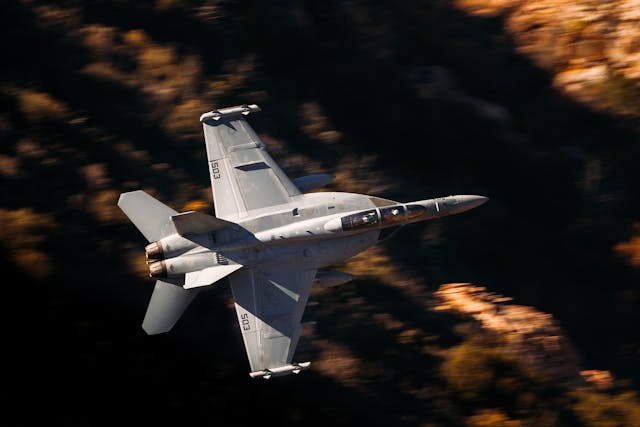
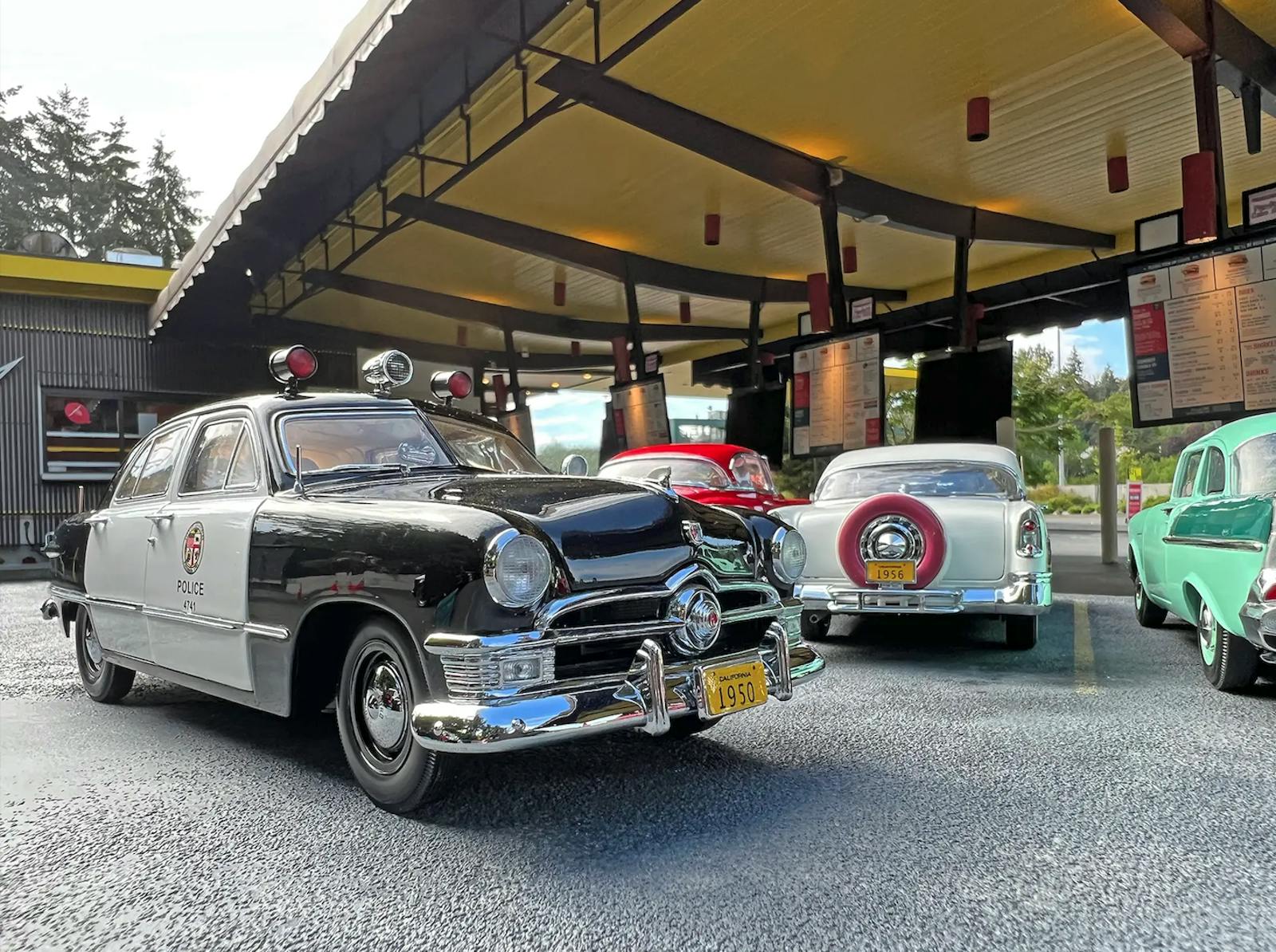

Do you have a patreon or venmo? i’d like to drop you some money for info on where you setup and location.
Thanks 🙂
Park at the Johnsondale Bridge parking lot, find a way down to the river trail and walk up river. (Staircase to river trail is down but I’m sure you can get down if you want bad enough) If you want jets at your feet, you need to find a trail up the side of the canyon or bush wack your own. Find a comfortable place to sit. Wait.
I would recommend getting there around sun up and plan on walking out by sundown. Take layers to keep warm and cool depending on the suns placement. It gets dark early and stays cold late into the morning. That is my advice. I don’t recall the last time I was on the trail and didn’t see multiple jets fly overhead.
Recent restrictions are supposed to prohibit the very low passes anymore. But they’ll get low enough and loud enough to push the limits of your senses. Especially if you get up the canyon off the river. You feel and hear them all at once on this stretch of the upper canyon. Then poof! they appear right overhead. The come and go quick and you had better be ready if you want a pic.
Years ago I remember a jet flying so low right over my head, I could see clearly the small print on its underside. Too long ago to remember what I read but it was an unforgettable jarring experience. I would have to guess that it was well under 100ft. And this was well downriver from Johnsondale Bridge, in the lower reaches of the upper canyon somewhere between Riverkern and Sherman Pass.
Good Luck